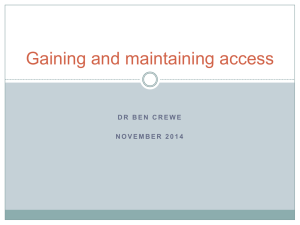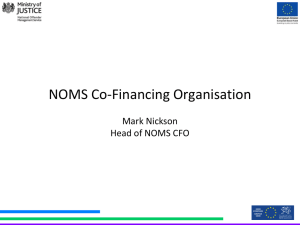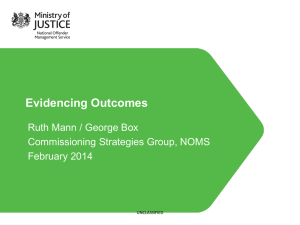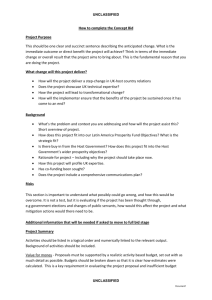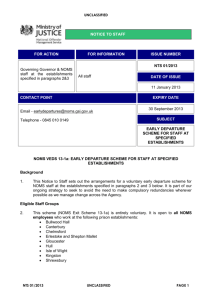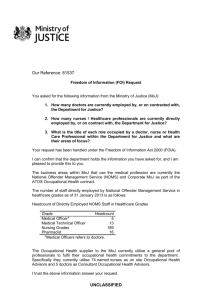Information Risk Management Policy - AI 04
advertisement
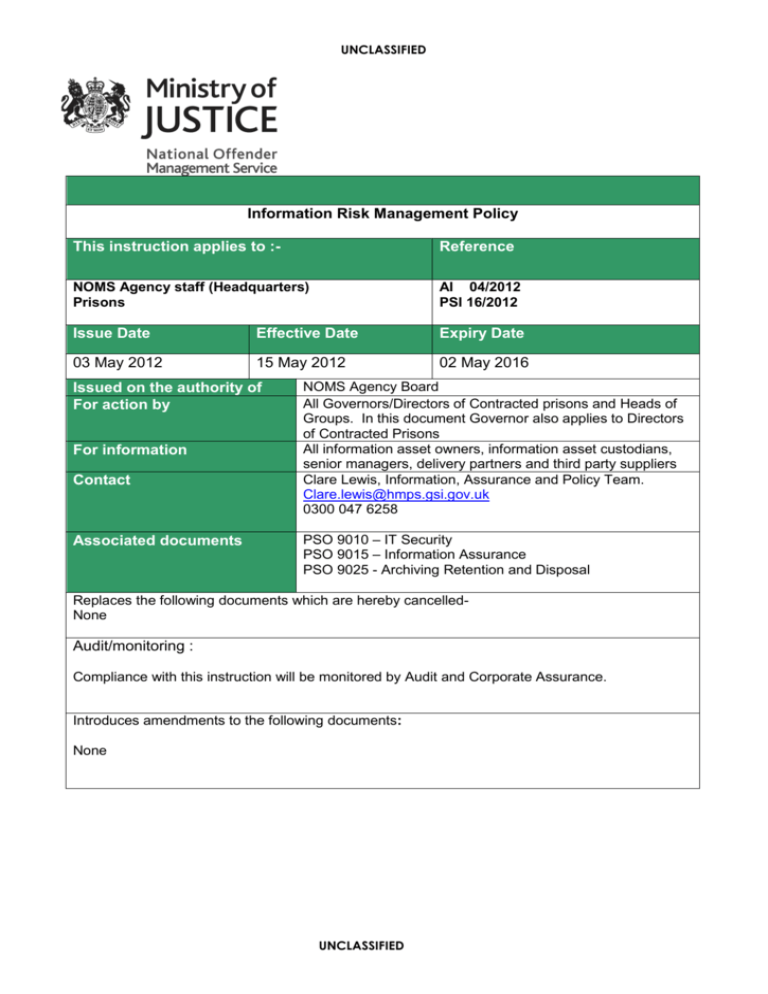
UNCLASSIFIED Information Risk Management Policy This instruction applies to :- Reference NOMS Agency staff (Headquarters) Prisons AI 04/2012 PSI 16/2012 Issue Date Expiry Date Effective Date Implementation Date 03 May 2012 15 May 2012 Issued on the authority of For action by For information Contact Associated documents 02 May 2016 NOMS Agency Board All Governors/Directors of Contracted prisons and Heads of Groups. In this document Governor also applies to Directors of Contracted Prisons All information asset owners, information asset custodians, senior managers, delivery partners and third party suppliers Clare Lewis, Information, Assurance and Policy Team. Clare.lewis@hmps.gsi.gov.uk 0300 047 6258 PSO 9010 – IT Security PSO 9015 – Information Assurance PSO 9025 - Archiving Retention and Disposal Replaces the following documents which are hereby cancelledNone Audit/monitoring : Compliance with this instruction will be monitored by Audit and Corporate Assurance. Introduces amendments to the following documents: None UNCLASSIFIED UNCLASSIFIED PAGE 1 CONTENTS Section 1 Subject Executive Summary 2 Information Risk Management 3 4 Compiling and Maintaining an Information Risk Register Business Continuity Planning 5 Physical and Personnel Security 6 Delivery Partners and Third Party Suppliers Annex A Roles and Responsibilities Annex B Annex C Information Assurance Risk Management Process Reviewing the Information Risk Register Annex D Information Risk Register - Example PSI 16/2012 – AI 04/2012 UNCLASSIFIED Applies to Governors, Head’s of Groups, Information Asset Owners, Information Asset Custodians Governors, Head’s of Groups, Information Asset Owners Information Asset Custodians Governors, Head’s of Groups, Information Asset Owners Governors, Head’s of Groups, Information Asset Owners Governors, Head’s of Groups, Information Asset Owners, Information Asset Custodians Governors, Head’s of Groups, Information Asset Owners, Information Asset Custodians Governors, Head’s of Groups, Information Asset Owners, Information Asset Custodians Governors, Head’s of Groups, Information Asset Owners Governors, Head’s of Groups, Information Asset Owners Governors, Head’s of Groups, Information Asset Owners ISSUE DATE 03/05/2012 UNCLASSIFIED 1 PAGE 2 Executive summary Background 1.1 Reliable and accurate information management is critical to proper decision making across the Ministry of Justice (MoJ). Information can take many forms and may or may not have protective markings – from data sets containing personal information through to records of sensitive meetings, policy recommendations, prisoner records, case files, correspondence and historical records. Information is the lifeblood of our organisation, it is a critical business asset that NOMS needs to protect and get the most value from to benefit the business The management of information risks should be incorporated into all day-to-day operations. If effectively used it can be a tool for managing information proactively rather than reactively. It will enable NOMS to get the right information to the right people at the right time, and help avoid incidents where data is lost or improperly disclosed. Desired outcomes 1.2 This policy sets out NOMS commitment to the management of information risk. It also sets out what prison establishments, headquarters groups, their ‘delivery partners’ and third party suppliers should do to manage information risk. In doing so, this policy supports the NOMS strategic aims and objectives and should enable employees throughout the organisation to identify an acceptable level of risk and, when required, use the correct risk escalation process. Application 1.3 Governors, Directors of Contracted Prisons, Head’s of Groups, Information Asset Owners and Information Asset Custodians must be familiar with the policy. Mandatory actions 1.4 Governors, Directors of Contracted Prisons, Heads of Groups and Information Asset Owners must ensure that Senior Management Teams and Information Asset Custodians review and are aware of this policy, a local Information risk policy must be produced and be available to all staff. All establishments and headquarters groups must have an Information Risk Register in place. The Information Asset Owner must carry out a quarterly review of the information risks Resource Impact 1.5 Initial completion of the risk register should take a group of senior managers between 4 - 6 hours, depending on the complexity of the prison. Quarterly reviews should take no longer that 1 -2 hours, depending on the number of actions identified. PSI 16/2012 – AI 04/2012 UNCLASSIFIED ISSUE DATE 03/05/2012 UNCLASSIFIED PAGE 3 2. Information Risk Management 2.1 Reliable and accurate information is critical to proper decision making in NOMS. This makes information a vital business asset that we need to protect. Information risk management provides this protection by managing risks to the confidentiality, integrity and availability (CIA) of information to assist our business to function effectively. 2.1 Confidentiality means ensuring that only authorised people can get to our information 2.3 Integrity means ensuring that it is authentic, accurate and complete 2.4 Availability means that authorised people can access it when they need to, at the right times in the right ways 2.4 Keeping the right information for the right period of time is also very important and can help ensure we comply with a range of statutory responsibilities (e.g. Freedom of Information 2000, Public Records Act 1958 & 1967, Data Protection Act 1998), supply information when it's requested by, for example, high-profile public enquiries, and provide supporting evidence in the event of litigation against NOMS. For guidance refer to PSO 9025 – Archiving, Retention and Disposal 2.5 Information Asset Owner (IAO) IAOs are responsible for the day to day use of information, which includes who has access to the information and risk management of their information. They are usually governing governors or heads of group but may be other senior managers such as IT system owners involved in running the relevant business area. 2.6 IAOs are responsible for making sure their business areas, delivery partners and third party suppliers with whom they work, have in place the arrangements needed to implement and maintain an effective information risk management policy. The IAO may wish to appoint Information Asset Custodians to work on their behalf, taking day to day oversight of assets and reporting back to the IAO on the changes to risks. Further information about the role of the IAO can be found in Annex A of this document and Appendix 1 of PSO 9015 - Information Assurance. 2.7 Information Risk Register IAOs must review information risks on a quarterly basis as part of the review of the establishment/business group Information Asset Register and, where appropriate, escalate any risks to the Information Policy and Assurance (IPA) Team at informationassurance@noms.gsi.gov.uk or by telephone on 0300 047 6590. As well as existing risks that have already been identified, the review must also consider forthcoming potential changes in services, technology and threats. Guidance on reviewing the Risk Register can be found in Annex C 2.8 The IPA team will decide whether it is appropriate to escalate any risks to the NOMS Senior Information Risk Owner (SIRO) (Annex A). NOMS is required to provide a report on information risk annually as part of a MoJ annual assessment of information risk and the information received from the IAOs forms part of this report. Additionally NOMS is required to provide quarterly risk updates to the MoJ SIRO Board. 2.9 The IAO must ensure that any Information and Communications Technology (ICT) systems that hold protectively marked information are accredited according to government PSI 16/2012 – AI 04/2012 UNCLASSIFIED ISSUE DATE 03/05/2012 UNCLASSIFIED PAGE 4 standards by a MoJ Accreditor. For further information on the accreditation process or to determine whether the ICT system is an accredited system please contact a member of the MoJ ICT team. 2.10 Disciplinary action will be considered for any member of staff (including contractors, consultants, and suppliers so far as is feasible) who do not follow the mandatory actions set out in this policy, unless prior agreement to do so has been secured from the NOMS SIRO. 3. Compiling and Maintaining an Information Risk Register 3.1 To provide evidence that the risks in their business area have been identified and that there are plans in place for managing them the IAO must compile and maintain an Information Risk Register. A well-organised and easy to understand Risk Register is fundamentally important. The register needs to provide enough information to the IAO to enable them to be able to identify and explain the risk management decisions within each business group 3.2 Each prison establishment and headquarters group will already have an Information Asset Register in place, this can be used to help to identify the different types of information assets held and provide direction on the risk to the organisation that a loss / compromise or lack of availability of that asset would have. 3.3 The Information Risk Register A partially completed risk register template that you can amend to fit your own establishment / business area can be found in Annex D. The draft has been provided to assist you but you will need to look at the information in each of the columns and consider the extent to which it is valid in your location. 3.4 You must include any additional risk descriptions and possible causes with establishment / business area specific risks and causes where necessary. 3.5 Prison establishments and business areas must use the NOMS Information Risk Register template provided, which contains the following information a description of each risk expressed in terms of the potential or actual compromise associated with the risk and the cause (threat and vulnerability), an indication of the Information Assurance (IA) controls already in place to remediate each risk, a rating that reflects the likelihood of the risk being realised and is typically expressed in terms of the ‘score’ assigned by the risk assessment method used, A rating that reflects the business impact associated with the threat being realised is typically expressed in terms of the ‘score’ assigned by the risk assessment process, a description of the IA controls that the business group has or plans to implement to further control the risk (together with any additional actions or contingency arrangements that lessen the business impact if the risk is realised), and a target date for implementing proposed IA controls or other plans to reduce the risk further. A target rating that reflects the score following the implementation of the further controls Guidance on completing a risk register can be found in Annex B An Excel version of the Risk Register template can be downloaded from the IPA team’s intranet pages. PSI 16/2012 – AI 04/2012 UNCLASSIFIED ISSUE DATE 03/05/2012 UNCLASSIFIED 3.6 PAGE 5 Escalating the Risk If a risk hits a certain ‘score’ it must be escalated to a specific management level. If a risk is given a collective impact/likelihood score of 9 or above, or an existing risk being managed at establishment level whose collective score for impact and likelihood is/becomes 9 or above, it must be escalated to the NOMS SIRO via the IPA Team. The NOMS IPA team can be contacted on informationassurance@noms.gsi.gov.uk or on 0300 047 6590. 3.7 It is unlikely that a risk with a score of 15+ will be identified in either prison establishments or headquarters groups that has not already been identified and included in the overall NOMS Information Risk Register. However any new/existing risks which are identified as having a score of 15 or above must be escalated to the MoJ SIRO Board by the IPA team. Further guidance on escalating risks to the appropriate level can be found in Annex B 3.8 The Annual Information and Assurance Compliance Statement required under PSO 9025 Archiving Retention and Disposal includes a statement giving assurance that your Risk Register is in place. The return must be completed and sent electronically to the NOMS IPA team at informationassurance@noms.gsi.gov.uk by 31 March each year. 4. Business Continuity Planning 4.1 The purpose of business continuity is to create the conditions that ensure a business can continue to operate even after an event that denies it access to its assets and information: this could be a server failure, a power cut, a fire or any other catastrophic event. 4.2 To ensure business continuity is maintained across NOMS all prison establishments must have in place a Contingency Plan for the loss of Prison NOMIS. The Governor/IAO is responsible for contingency plans within their establishment and must nominate suitable personnel for undertaking tasks identified in the plan. Whilst HPES will be responsible for managing the resolution of the disruption, it is the responsibility of the IAO to make sure that all staff are aware of the contingency plans and have enough knowledge to implement them. 4.3 It is important that IAOs in both establishments and headquarters identify their local 'vital records'. These are information assets that are not held on the Quantum system but have been identified as essential for the continuation of NOMS operations if, for example, stand alone IT systems and / or paper records cannot be accessed. 4.4 The plan must identify proposals for the recovery of business critical activities promptly and efficiently and include proposals for the protection of local ‘vital records’ and NOMS information assets. 4.4 For guidance on putting in place suitable business continuity and contingency plans for ICT systems prison establishments may wish to consult with MoJ ICT. 4.5 For staff in headquarters and regional offices PSO 1401 Para 1.2 - Business Continuity Management Manual provides guidance on business continuity planning. 5. Physical and Personnel Security 5.1 Physical Security - Security managers in prison establishments and headquarters buildings must assess any physical security risks that affect the sites and environments in which ICT- PSI 16/2012 – AI 04/2012 UNCLASSIFIED ISSUE DATE 03/05/2012 UNCLASSIFIED PAGE 6 based and paper-based information systems reside. They must ensure that IAOs (and ICT accreditors) are made aware of any assessed risks that affect them. 5.2 Personnel security - All staff must have the appropriate level of checking or ‘vetting’ needed to assure the reliability of each employee (including contractors) according to the sensitivity of the information that the member of staff has regular access to and the business impact that might arise if that employee discloses this information without authority. Refer to AI 24/2010 or PSI2010/43 – Security Vetting for more information. 6. Delivery Partners and Third Party Suppliers 6.1 NOMS Delivery Partners and Third Party Suppliers must identify and manage risks to all NOMS information assets that they have access to and/or control of, including escalating them via the necessary channels as outlined in this policy (via the IAO, the IPA Team and NOMS SIRO). 6.2 Any significant risks relating to NOMS information must be raised with the relevant point of contact and if required the relevant IAO, as outlined in this policy. Any enquiries regarding the instructions contained within this policy should be directed to The NOMS IPA team at informationassurance@noms.gsi.gov.uk or on 0300 047 6590. (approved for publication by:) Martin Bellamy, NOMS Senior Information Risk Owner (SIRO) Director of Change and ICT, NOMS PSI 16/2012 – AI 04/2012 UNCLASSIFIED ISSUE DATE 03/05/2012 UNCLASSIFIED PAGE 7 Annex A Roles and Responsibilities 1. MoJ SIRO Board; SIRO means Senior Information Risk Owner. The Board is composed of all of the MoJ’s Business Group SIROs and Executive Agency SIROs. The Board is chaired by the MoJ SIRO. 2. NOMS Senior Information Risk Owner (SIRO); The NOMS SIRO has overall responsibility for all NOMS information assets in NOMS Headquarters and prison establishments. The NOMS SIRO sits on the SIRO Board and provides assurance that all information asset owners in NOMS are following their responsibilities. The NOMS SIRO is the NOMS CICT Director; they are the focus for the management of information risk at Board level, are familiar with information risks and would lead the NOMS response in the event of a major data incident. 3. Information Asset Owners (IAOs); are usually governing governors or heads of group but may be other senior managers involved in running the relevant business area. They are responsible for the day to day use as well as the risk management of their information asset, and supporting the NOMS SIRO in carrying out their duties. IAOs identify and manage information risks associated with the particular NOMS Information Asset(s) they are responsible for. Their role is to understand what information is held, what is added and removed, and who has access and why as well as ensuring that information is fully used within the law for the public good, and providing written input annually to the NOMS SIRO on the security and use of their asset. IAOs are also responsible for ensuring that appropriate business continuity plans are in place for their prison establishment or business area. IAOs are responsible for implementing this information risk management policy in their respective business areas, and for regularly reviewing the policy. To this end the IAOs are responsible for making sure their business areas, and the delivery partners and third party suppliers with whom they work, have in place the arrangements needed to implement and maintain an effective information risk management policy. The IAO may wish to appoint Information Asset Custodians to work on their behalf, taking day to day oversight of assets and reporting back to the IAO on the changes to risks. Further information about the role of the IAO can be found in Appendix 1 of PSO 9015 - Information Assurance. 4. Information Asset Custodians (IAC) are involved in the day to day use and management of information assets in a particular area, they will be appointed by the IAO to have responsibility for overseeing and implementing the necessary safeguards to protect the information assets and report back to the IAO on any changes to risks. The IAO will retain the overall responsibility. 5. The Information Policy and Assurance (IPA) Team is based in the Change and Information Communication Technology Directorate (CICT). The team aims to provide information management to deliver business benefits and efficiency savings, reduce information risk and facilitate compliance with information legislation. Its role is to enable, monitor and develop Information Assurance Maturity and Compliance within NOMS. The team also owns and maintains the NOMS Information Risk Register and provides written advice to the NOMS SIRO on the security and use of NOMS assets. PSI 16/2012 – AI 04/2012 UNCLASSIFIED ISSUE DATE 03/05/2012 UNCLASSIFIED PAGE 8 Annex B Information Assurance Risk Management Process Risk management is an iterative process. It encompasses the following stages: Risk Identification, Risk Assessment, Risk Monitoring and Escalation. A Risk Register that provides enough information to explain risk management decisions will enable the IAO to monitor and manage the risks within their business group. A partially completed risk register template that you may wish to amend to fit your business group can be found in Annex D. The draft has been provided to help you to prepare your local document. In order to complete it you will need to look at the information in each column and consider the extent to which it is true in your location and provide an appropriate risk rating. You must include any additional risk descriptions with establishment / business area specific risks, causes and mitigating actions and also include the possible consequences of the risk being compromised where necessary. An Excel version of the Risk Register template can be downloaded from the IPA Team’s intranet pages. Stage 1 - Risk Identification: 1.1 Situations where risks must be identified may take many forms, for example: Preparation to develop a new Information Communication Technology (ICT) based or paper-based information system, Regular review under ‘business as usual’ arrangements for maintaining IA, and Work to address a change of requirement. 1.2 The starting point in these examples is risk analysis: being clear on what information assets fall within scope of the assessment and the importance of those assets to the business (or the impact of loss of confidentiality, integrity or availability). 1.3 Each prison establishment or business group will already have an Information Asset Register in place, this can be used to help to identify the different types of information assets held and to provide direction on the risk to the organisation that a loss / compromise of that asset would have. Some examples of information assets are: 1.4 Staff and HR Details Official Correspondence Prisoner records and reports Financial budgetary information Litigation or caseworking files Once you have considered the information assets that might be at risk you need to identify the ‘risk description’ which is the form that the compromise / loss might take. The following suggestions are some of the factors that you might want to consider as ‘risk descriptions’ when completing your own register, this list is only for guidance and you might identify different or additional risks that are more appropriate in your own business area: Inappropriate disclosure of personal material PSI 16/2012 – AI 04/2012 UNCLASSIFIED ISSUE DATE 03/05/2012 UNCLASSIFIED 1.5 1.6 PAGE 9 Theft, loss or unauthorised access to information (paper records should be considered as well as electronic and systems) Ineffective or insecure information sharing Records retained for the wrong length of time Failure to create or locate reliable records as evidence of business decisions and activities Poor management of information risk Stand alone IT systems that are not supported through Quantum Once you have identified the ‘risk description’, the next step is to identify the organisations, people or events that pose a threat to your information assets. The following are just a few of the possible causes of information loss / compromise but you need to consider which of these are true in your business area and update the Risk Register to reflect this: Lack of awareness and training Absence of information sharing agreements Password sharing Documents sent to incorrect address or lost/compromised during transmission Dishonesty Inappropriate storage Records retained unnecessarily result in large volumes of data to be searched. Unavailability of business continuity plans An important part of the risk identification process for IT systems is through the accreditation process. Further information on this process can be found in PSO 9010 - IT Security. Stage 2 - Assessing the Scale of Risk: 2.1 Assessing a risk involves evaluating two factors, these are: The Impact to the organisation where the compromise/loss to occur, and The Likelihood of the risk being realised, taking into account the working environment and past experience. 2.2 The assessment of these factors helps you to decide on the overall severity of each risk, this means that they can be prioritised and resources focused on the most serious. 2.3 The table below illustrates what score is attached to each level for both impact and likelihood. Once you have decided on the scores they are multiplied together to give the overall risk score. 2.4 For example: A risk is determined to have a ‘significant detrimental effect in the long term’ would have a score of High (4). It is then judged the likelihood of this occurring is unlikely giving a score of Low (2). This is multiplied to give a total risk score of 8. This score is then used to determine if the risk needs escalating. PSI 16/2012 – AI 04/2012 UNCLASSIFIED ISSUE DATE 03/05/2012 UNCLASSIFIED PAGE 10 IMPACT Scale LIKELIHOOD 5 Very High Prevents achievement of NOMS objectives or has highly damaging impact on NOMS operational effectiveness or reputation. . > 80 % Almost Certain 4 High Significant detrimental effect on achievement of NOMS corporate objectives in the longer term. National media criticism. 51 – 80 % Probable 3 Medium Impacts at local level on elements of efficiency, output and quality which impacts on the outcome of long term NOMS corporate objectives. Potential for negative local media coverage 21 – 50 % Possible 2 Low Impact at local level on short term goals within their objectives without affecting long term achievement of NOMS corporate objectives. 6 – 20 % Unlikely 1 Very Low Minor and containable impact on achievement of local (establishment / business area) objectives. <5% Very Unlikely Risk scores can be shown on a matrix: Risk A: Very High Impact (5), and High Likelihood (4), giving a score of 20; Risk B: High Impact (4), and Medium Likelihood (3), giving a score of 12; Risk C: Low Impact (2), and High Likelihood (4), giving a score of 8. 2.5 The risk scores are used to decide if the level of risk is acceptable, or if further action to mitigate is required, (e.g. controls, escalation and/or contingency plans). Stage 3 - Managing the risk: 3.1 There are generally four options that the IAO must consider when deciding how to manage the identified risk. PSI 16/2012 – AI 04/2012 UNCLASSIFIED ISSUE DATE 03/05/2012 UNCLASSIFIED PAGE 11 3.2 The first one is ‘treating the risk’ which is done by applying one or more Information Assurance controls to reduce the likelihood of the risk being realised or lessen the impact if the risk is realised. Examples of these controls could be: Implementing the mandatory actions in PSO 9015 – Information Assurance Implementing the mandatory actions in PSO 9025 - Archiving Retention and Disposal Using the Government Protective Marking Scheme Investigation of incidents and lessons learned Training and awareness Putting in place suitable business contingency plans 3.3 The second option is ‘removing the risk’, this is done by finding another way to achieve a business objective; for example returning protectively marked documents to the originating department rather than storing them within NOMS. 3.4 Another possible option to consider is ‘transferring the risk’ by outsourcing services. It is important to recognise that even if it is possible to transfer responsibility for managing a risk to an organisation other than NOMS, the consequences of a risk will rest wherever the business impact associated with it being realised is felt. The legal basis for sharing information and appropriate contractual provisions and arrangements to ensure compliance with control requirements must be in place. 3.5 Finally the IAO could decide that ‘tolerating the risk’ is the most appropriate action. This is usually done where: the financial cost of mitigation is too great, where the likelihood of the risk being realised is low, where the impact on the organisation if the risk is realised is low or else where the business benefit is high. Stage 4 – Monitor and Escalate: 4.1 An ongoing programme of periodic monitoring, inspection and testing is required which validates and provides evidence that the IA controls used to manage risks remain effective. 4.2 An annual Information and Assurance Compliance Statement is required under PSO 9025 - Archiving Retention and Disposal, the statement must be completed on an annual basis and includes a statement giving assurance that your Risk Register is in place. 4.3 In addition to this the IAO must carry out a quarterly review of the information risks. As well as existing risks that have already been identified, the review must also consider forthcoming potential changes in services, technology and threats. Reviews must be discussed at local SMT level and minuted. 4.4 Where the risk relates to ICT-based information systems: Business groups must use Her Majesty’s Government’s (HMG) accreditation process to assess, treat, validate and verify risk to all ICT-based information systems on which their business operations depend. For further information on the accreditation process or to determine whether the ICT system is an accredited system please contact a member of the MoJ ICT team. 4.5 If a risk hits a certain score it must be escalated to a specific management level. This is set out below; Very High High Med PSI 16/2012 – AI 04/2012 (I/L 20-25) (I/L15 - 19) (I/L 9 - 14) MOJ Board via the Corporate Risk Register SIRO Board through the NOMS IPA Team NOMS SIRO through the NOMS IPA Team UNCLASSIFIED ISSUE DATE 03/05/2012 UNCLASSIFIED 4.6 Low V. Low (I/L 5 - 8) (I/L 1 - 4) PAGE 12 Information Asset Owner Can be managed at Business Group level How does it work in practice? The description below illustrates the step by step process. Step 1 (Risk registration) - Any new risk which has a collective impact/likelihood score of 9 or above, or an existing risk being managed at Business Group level whose collective score for impact and likelihood is/becomes 9 or above, must be escalated to the NOMS SIRO via the NOMS IPA Team at informationassurance@noms.gsi.gov.uk or by telephone on 0300 047 6590. Step 2 (Risk acceptance) - The NOMS SIRO will review any proposed new risks and make a decision on whether to accept, reject or transfer the risk to a new owner. The NOMS SIRO will also agree that the scoring is appropriate, the mitigating actions, target dates and risk owner. Step 3 (Escalation to SIRO Board) - It is unlikely that a risk score of 15+ will be identified in either prison establishments or headquarters groups that has not already been identified and included in the overall NOMS Information Risk Register, however any new/existing risks which are identified as having an impact/likelihood score of 15 or above will be escalated to the SIRO Board who will consider whether the risk should be escalated to the Corporate Risk Register (generally a score of 20-25) and if appropriate the Corporate Risk Team will notify the Departmental Board. These risks will require an accompanying action plan (or risk treatment plan) setting out in detail the full risk, the controls in place, the proposed mitigating controls and a detailed timeline to completion. Additionally, SIROs will be required to provide updates on these significant risks. 4.7 Step 4 (Closure) - Risks with a score of 15+ which are tabled for closure will need to go to the SIRO Board with an accompanying closure report (which may be an updated action plan, outlining all of the mitigations which are in place, the target score which has been achieved and any residual risk). It is worth remembering that when risks are escalated and assessed at the next management level, that the level of impact is likely to be moderated as objectives and responsibilities widen. Therefore, a risk identified at local level may often (although not in all cases) have a lower impact upon the overall NOMS business objective. PSI 16/2012 – AI 04/2012 UNCLASSIFIED ISSUE DATE 03/05/2012 UNCLASSIFIED PAGE 13 Annex C Reviewing the information Risk Register 1.1 IAOs must review information risks on a quarterly basis and, where appropriate, escalate any risks to the Information Policy and Assurance (IPA) Team. At each review consider if existing risks are still relevant, achieve the same score and if new risks have emerged. Even where risks remain the same, it is likely that controls and contingency plans will require updating 1.2 Where an operationally significant risk has been identified the IAO will need to describe the mitigating actions that will be put in place and then assess the residual risk rating, taking into account the additional measures that are being proposed. When the review of the Risk Register is carried out the IAO must take into account when the mitigating actions have been carried out so they can be entered onto the register as control measures (Annex D) 1.3 As well as existing risks that have already been identified, the review must also consider forthcoming potential changes in services, technology and threats. . PSI 16/2012 – AI 04/2012 UNCLASSIFIED ISSUE DATE 03/05/2012 UNCLASSIFIED PAGE 14 Annex D Information Risk Register Information Asset Owner ………………………………………………………………………………………… Controls: In Place and Active (Transfer to Controls Proposed / planned column where Controls are not currently in place) Effect(s) 1 Lack of awareness training, Absence of Information Sharing Agreements (ISAs), Requests to access information are not escalated to Information Asset Owner, Failure to check contents of disclosure, Failure to follow Government Protective Marking Scheme (GPMS) Serious and unwarranted damage and distress to individuals Breach of DPA and infringement of privacy Regulatory, court action or financial penalties damage to reputation and integrity Cost and resources required to investigate PSI 16/2012 – AI 04/2012 L I Controls: Proposed / Planned (incl. Date/Action Officer) Obtaining guidance and support regarding incident management from Information Assurance Team, Local Information Sharing Agreements (Identify local agreements here if they are in place) Annual Information Assurance Training (enter current completion rate) Target L I Compliance with PSO 9015 - Information Assurance, L Risk Owner Control Owner Date 100% Annual level 1 information assurance training completed for all staff by 31 March / Action: Additional Action Cause(s) Risk (Event) I Inappropriate Disclosure of personal data Current Risk ID Risk Description Last Period HMP/Business Group …………………………… IAO Reference Guide read by IAO and recorded in annual compliance statement Action: Information Assurance Audit compliance by………….. Action: IA Audit compliance (enter current score) Identified IA roles in place (IAO, Custodian, LIM, IAR) UNCLASSIFIED ISSUE DATE 03/05/2012 3 Compliance with PSO 9010 - IT Security Inadequate access and permissions management Password sharing Poor information asset management Dishonesty Emails sent to wrong address or lost compromised during transmission Non-Quantum IT breaches security requirement - i.e. 5x5 data transfers and backups Inadequate business continuity planning Serious and unwarranted damage and distress to individuals Breach of DPA and infringement of privacy Regulatory, court action or financial penalties damage to reputation and integrity Cost and resources required to investigate Cost of recreating / retrieving information Compliance with PSO 9015 – Information Assurance Theft, loss or unauthorised access to information (paper based) Compliance with PSO 9010 - IT Security Risk (Event) Effect(s) 2 Theft, loss or unauthorised access to information (electronic and systems related PSI 16/2012 – AI 04/2012 PAGE 15 Data Loss Reporting guidelines issues to all staff by………. Action Implementation of the Government Protective Marking Scheme Additional Action Compliance with PSO 9020 – Data Protection, FOI Only laptops, Blackberrys and USB memory sticks encrypted to HMG standards will be used Annual Information Assurance training (enter current completion rate) Regular data backups are carried out and up to date backup logs are kept Compliance with PSO 9020 – Data Protection, FOI Compliance with PSO 9015 – Information Assurance UNCLASSIFIED Additional Action Cause(s) Risk (Event) UNCLASSIFIED Data Loss Reporting guidelines issues to all staff by………. Action ISSUE DATE 03/05/2012 Implementation of the Government Protective Marking Scheme Ineffective or Insecure Information Sharing Compliance with PSO 9015 - Information Assurance, PAGE 16 Annual Information Assurance training (enter current completion rate) Obtaining guidance and support from Information Assurance Team, Local Information Sharing Agreements (Identify local agreements here if they are in place) Additional Action 4 lack of awareness of failure to follow protective marking or inappropriate classification Documents stored in damp conditions and damaged beyond repair Documents not filed correctly and not available to be retrieved Dishonesty / sabotage Carelessness Clear desk policy not enforced Documents posted / faxed to wrong address or lost / compromised during transmission Serious and unwarranted damage and distress to individuals Breach of DPA and infringement of privacy Regulatory, court action or financial penalties damage to reputation and integrity Cost and resources required to investigate Cost of recreating / retrieving information Risk (Event) Effect(s) Cause(s) UNCLASSIFIED Effective business continuity plans in place PSI 16/2012 – AI 04/2012 UNCLASSIFIED ISSUE DATE 03/05/2012 Cause(s) 5 PAGE 17 Information sharing agreements not in place or not comprehensive enough Failure to share the right information with the right people at the right time Shared information is not stored securely or in line with GPMS Shared information that is held electronically is not stored on secure and accredited ICT systems Information used for purposes other than those agreed failure to disclose critical information for offender case management Serious & unwarranted damage and distress to individuals Adverse effect on prisoner discipline Breach of DPA and infringement of privacy damage to reputation and integrity Information not shred prior to the departure of staff - knowledge not retained Loss of business continuity Records Retained for the Wrong Length of Time Compliance with PSO 9025 - Archiving, Retention and Disposal Local Information Manager and deputy in post Information not covered by retention policy lack of awareness and motivation Dishonesty / sabotage Records retained 'just in case' Records not removed from non-Quantum IT systems in line with retention policy PSI 16/2012 – AI 04/2012 Local Information Manager and deputy received training UNCLASSIFIED Additional Action Risk (Event) Effect(s) Cause(s) UNCLASSIFIED ISSUE DATE 03/05/2012 Effect(s) 6 Breach of DPA, FOI & Public Records Act Breach of other requirements for the retention of records Unnecessary cost of storage of physical and electronic information Inability to protect NOMS best interests in cases of litigation because relevant records have been destroyed Premature destruction seen as an attempt to prevent disclosure regulatory, court or financial penalties Damage to reputation and integrity Failure to Create or Locate Reliable Records as Evidence of Business Decisions and Activities Records not created in the first place to document key decisions and activities records retained unnecessarily result in large volumes of data to be searched in information is requested records are not managed systematically and electronic and physical filing is not carried out PAGE 18 Compliance with PSO 9015 - Information Assurance Compliance with PSO 9025 Archiving, Retention and Disposal Effective review and destruction process in place Effective use of Shared Drive folders on Quantum system Additional Action Cause(s) Risk (Event) Effect(s) UNCLASSIFIED Breach of DPA and FOI records required for evidential purposes (i.e. in court) will not be available legal action against NOMS critical information can't be found or takes too long to find when needed PSI 16/2012 – AI 04/2012 UNCLASSIFIED ISSUE DATE 03/05/2012 Vital records and NOMS information Assets lost as a Result of server failure, a power loss, fire or any other catastrophic event Vital records not identified in local business continuity plan Contingency plans are not in place for non Quantum IT systems such as SIS business continuity plans are not in place Compliance with PSO 1400 Contingency planning Effective contingency plans in place for Prison NOMIS systems Effective business continuity plans in place for Non Quantum IT systems such as SIS Vital records are identified and identified within local continuity plans 7 Effect(s) PAGE 19 Additional Action Cause(s) Risk (Event) UNCLASSIFIED Vital records may be destroyed in the event of an incident or failure Unable to access information with potential legal & financial consequences Significant investment required in the case of a major incident or failure Business continuity affected Desk top contingency exercise carried out every 12 months Date Signed Off by Information Asset Owner …………………………………. PSI 16/2012 – AI 04/2012 UNCLASSIFIED ISSUE DATE 03/05/2012 UNCLASSIFIED EIA PAGE 1 EIA Equality Impact Assessment PSI 16/2012 Information Risk Management Policy Stage 1 – initial screening The first stage of conducting an EIA is to screen the policy to determine its relevance to the various equalities issues. This will indicate whether or not a full impact assessment is required and which issues should be considered in it. The equalities issues that you should consider in completing this screening are: Race Gender Gender identity Disability Religion or belief Sexual orientation Age (including younger and older offenders). Aims What are the aims of the policy? This policy sets out NOMS commitment to the management of information risk. It also sets out what prison establishments, private prisons, headquarters groups, their ‘delivery partners’ and third party suppliers should do to manage information risk. Effects What effects will the policy have on staff, offenders or other stakeholders? This policy supports the NOMS strategic aims and objectives and should enable employees throughout the organisation to identify an acceptable level of risk and, when required, use the correct risk escalation process. Evidence Is there any existing evidence of this policy area being relevant to any equalities issue? Identify existing sources of information about the operation and outcomes of the policy, such as operational feedback (including local monitoring and impact assessments)/Inspectorate and other relevant reports/complaints and litigation/relevant research publications etc. Does any of this evidence point towards relevance to any of the equalities issues? There is no existing evidence that this policy area has relevance to any equalities issue Stakeholders and feedback Describe the target group for the policy and list any other interested parties. What contact have you had with these groups? Governors, Directors of contracted prisons, Heads of Groups and Information Asset Owners have a specific interest in this policy. All senior managers and information asset custodians should be aware of the policy. Consultation has been carried out with a sample group of Information Asset Owners, MoJ ICT and IA, PAG and Unions. PSI 16/2012 – AI 04/2012 UNCLASSIFIED ISSUE DATE 03/05/2012 UNCLASSIFIED EIA PAGE 2 Do you have any feedback from stakeholders, particularly from groups representative of the various issues, that this policy is relevant to them? No feedback has been received from stakeholders Impact Could the policy have a differential impact on staff, prisoners, visitors or other stakeholders on the basis of any of the equalities issues? The policy is designed to ensure that information risks are managed consistently across prison establishments and headquarters. It will not therefore have a differential impact in staff on the basis of any equalities issues. Local discretion Does the policy allow local discretion in the way in which it is implemented? If so, what safeguards are there to prevent inconsistent outcomes and/or differential treatment of different groups of people? The mandatory policy must be followed with regard to the completion of the Information Risk Register and the compliance statement. The Information Asset Owner (IAO) will need to spend time monitoring and reviewing local processes and the local management plan may differ from business area to business area. However this will relate to the risk management of information assets and not the management of staff or offenders Summary of relevance to equalities issues Strand Race Gender (including gender identity) Disability Religion or belief Sexual orientation Age (younger offenders) Age (older offenders) Yes/No Rationale No No The instruction applies to the risk management of information assets and not the management of staff or offenders As above No As above No As above No As above No As above No As above If you have answered ‘Yes’ to any of the equalities issues, a full impact assessment must be completed. Please proceed to STAGE 2 of the document. If you have answered ‘No’ to all of the equalities issues, a full impact assessment will not be required, and this assessment can be signed off at this stage. You will, however, need to put in place monitoring arrangements to ensure that any future impact on any of the equalities issues is identified. PSI 16/2012 – AI 04/2012 UNCLASSIFIED ISSUE DATE 03/05/2012 UNCLASSIFIED EIA PAGE 3 Monitoring and review arrangements Describe the systems that you are putting in place to manage the policy and to monitor its operation and outcomes in terms of the various equalities issues. There is no evidence that equalities issues are relevant to the implementation of this policy. The policy will be managed through a network of Information Asset Owners (IAOs) in prison establishments and headquarters. Compliance will be formally monitored through submission of the compliance statement. State when a review will take place and how it will be conducted. A review will take place when the Instruction is reviewed, following a change in legislation or if evidence comes to light which indicates that equalities issues need to be raised. Policy lead Head of group Name and signature Date Clare Lewis 17 Nov 11 Paul Duffin 17 Nov 11 PSI 16/2012 – AI 04/2012 UNCLASSIFIED ISSUE DATE 03/05/2012
